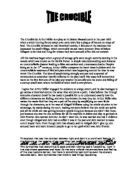Witches were seen as disgusting, evil people as can be seen in great influences within puritan literature such as Shakespeare. Shakespeare depicted the witches in his own play ‘Macbeth’ as foul-mouthed evil women, because he suggested they were so powerful and their power was channelled from the Devil. There is no way that in these times they could be depicted as pure or innocent as puritan were meant to be. Also Hathorne and Danforth actually represent several judges, all of equal authority in the 17th century witch trials, almost acting like a jury. After just a couple of weeks of the accusations many people were jailed on charges of witchcraft and by the end of the trials almost 20 people had been found guilty and hung for their supposed crimes. These numbers show that based upon very little evidence so many people could be convicted of confiding in witchcraft. In Puritan society blasphemy was considered the ultimate crime, and so therefore any such allegation would result in being put in trial with little chance of any redemption from society.
It was incredibly contradicting that these very pure and strictly religious people were accusing many innocent citizens of practising witchcraft because by doing so they were actually the ones that were committing the sin. They were the ones going against there own faith by making suspected witches out of perfectly innocent people. It was described by Miller as being ‘one of the strangest and most awful chapters in human history’, which would suggest how encapsulated Miller was in the subject. The witch trials of 1692 tore the community apart and spilled many unspoken jealousies between the town folk.
But this is very similar to what was happening in the United States at the time when Miller was writing the book. Miller wrote the book during the session of Senator Joseph McCarthy, a man whom during the early 1950’s managed to take the USA into a black patch, namely the Cold War against the USSR. McCarthy was an overwhelmingly anti-communist senator who managed to come to session due to the poor relationship Truman had with the US public. McCarthy was basically the whole force that propelled the US into a huge anti-communist fervour. He conducted trials in America that mirrored those in Salem in 1692. These trials later became known as the ‘Communist Witch Hunts’. Oddly the US was very co-operative with McCarthy’s ways. He managed to have many on his side even though he was going against the books and amendments made by fellow Americans years before him. Most notably he broke the 5th amendment, his own view was the one that counted. If someone remained silent in McCarthy’s trials then they were guilty. In 1950 McCarthy spoke at Wheeling claiming that there were 205 communists in the state department (embarrassingly for him this number was later, publicly, reduced to 57), the similarity being that in Salem in 1692 many were accused of witchcraft, many of the accusers had no evidence they merely spilled out old grudges. This period left the US in mass hysteria that the country was to become communist and that there was many communists in controlling and influential positions within the media, society and state departments. The whole country and its people felt insecure about the future of the USA.
McCarthy was very focal on the liberal entertainment industry, which Miller was apart of, he accused many of them of being communist or otherwise communist sympathisers. Those suspected were ‘blacklisted’ which led to them being unable to get employment in the industry. Film star Robert Taylor accused many fellow actors as being a “disrupting influence in the entertainment industry”. However those that were being hunted or suspected by McCarthy’s regime, set up a committee in which they could speak out at what was happening, The House of Un-American Activities Committee. Many very influential personalities were called to speak at the meeting such as Bertolt Brecht. As well, Miller was called to the HUAC to talk. It is surely a certainty that Miller was affected and absorbed by McCarthy’s communist witch hunts in the 1950’s, but he did not write ‘The Crucible’ against McCarthy’s trials, these trials merely presented a great link and familiarity for Miller who had studied the Salem witch trials in depth at University.
But apart from putting ‘The Crucible’ in the context of 50’s McCarthyism and highlighting the link between the two, it is important to be able to outline the play’s relevance to modern 21st century society. There have been a number of relevant global happenings in recent years, such as the US and British government and UN and NATO weapon inspectors accusing the Iraqis of having chemical weapons in which they aim to use in line with creating mass destruction. The media, just like the gossiping town folk of Salem, manage to convey the possibilities of the potential destruction leaving the people insecure about there future.
Also the events of September 11th 2001, when New York City was the victim of surely the worst terrorist act ever committed. The events that day sent the whole of the western world upside down. The rest of the US and Brits were especially sure that they were next. People were hysterical about what was happening and people were literally staying at home away from the supposed danger. For 18 months after, the numbers of people using airlines to commute had dropped drastically.







